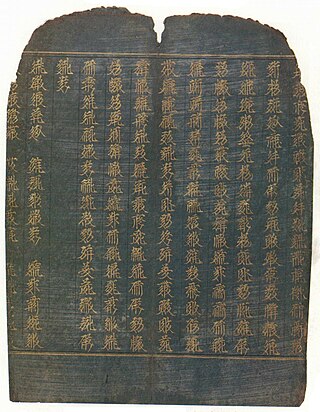
Sino-Tibetan, also cited as Trans-Himalayan in a few sources, is a family of more than 400 languages, second only to Indo-European in number of native speakers. Around 1.4 billion people speak a Sino-Tibetan language. The vast majority of these are the 1.3 billion native speakers of Sinitic languages. Other Sino-Tibetan languages with large numbers of speakers include Burmese and the Tibetic languages. Other languages of the family are spoken in the Himalayas, the Southeast Asian Massif, and the eastern edge of the Tibetan Plateau. Most of these have small speech communities in remote mountain areas, and as such are poorly documented.

The Tibetic languages form a well-defined group of languages descended from Old Tibetan. According to Tournadre (2014), there are 50 languages, which split into over 200 dialects or could be grouped into 8 dialect continua. These languages are spoken in the Tibetan Plateau and in the Himalayas in Gilgit-Baltistan, Aksai Chin, Ladakh, Nepal, Himachal Pradesh, Uttarakhand, and Bhutan. Classical Tibetan is the major literary language, particularly for its use in Buddhist literature.

Tangut is an extinct language in the Sino-Tibetan language family.
Khams Tibetan is the Tibetic language used by the majority of the people in Kham. Khams is one of the three branches of the traditional classification of Tibetic languages. In terms of mutual intelligibility, Khams could communicate at a basic level with the Ü-Tsang branch.
Qiangic is a group of related languages within the Sino-Tibetan language family. They are spoken mainly in Southwest China, including Sichuan and northern Yunnan. Most Qiangic languages are distributed in the prefectures of Ngawa, Garzê, Ya'an and Liangshan in Sichuan with some in Northern Yunnan as well.

The Tibeto-Burman languages are the non-Sinitic members of the Sino-Tibetan language family, over 400 of which are spoken throughout the Southeast Asian Massif ("Zomia") as well as parts of East Asia and South Asia. Around 60 million people speak Tibeto-Burman languages. The name derives from the most widely spoken of these languages, Burmese and the Tibetic languages, which also have extensive literary traditions, dating from the 12th and 7th centuries respectively. Most of the other languages are spoken by much smaller communities, and many of them have not been described in detail.

Guillaume Jacques is a French linguist who specializes in the study of Sino-Tibetan languages: Old Chinese, Tangut, Tibetan, Gyalrongic and Kiranti languages. He also performs research on the Algonquian and Siouan language families and publishes about languages of other families such as Breton. His case studies in historical phonology are set in the framework of panchronic phonology, aiming to formulate generalizations about sound change that are independent of any particular language or language group.
Horpa are a cluster of closely related Gyalrongic languages of China. Horpa is better understood as a cluster of closely related yet unintelligible dialect groups/languages closely related to Horpa Shangzhai or Stodsde skad. The term Stodsde skad is a Tibetan name meaning "language of the upper village".

Gyalrong or rGyalrong, also rendered Jiarong, or sometimes Gyarung, is a subbranch of the Gyalrongic languages spoken by the Gyalrong people in Western Sichuan, China. Lai et al. (2020) refer to this group of languages as East Gyalrongic.
The Burmo-Qiangic or Eastern Tibeto-Burman languages are a proposed family of Sino-Tibetan languages spoken in Southwest China and Myanmar. It consists of the Lolo-Burmese and Qiangic branches, including the extinct Tangut language.
The Rung languages are a proposed branch of Sino-Tibetan languages. The branch was proposed by Randy LaPolla on the basis of morphological evidence such as pronominal paradigms. However, Guillaume Jacques and Thomas Pellard (2021) argues that these languages do not constitute a monophyly based on recent phylogenetic studies and on a thorough investigation of shared lexical innovations.
Situ is a Rgyalrong language spoken in Sichuan, China. The name "Situ", literally "four Tusi", comes from a historical name of the Ma'erkang region.
Zbu, or Showu, is a Rgyalrong language spoken in Sichuan, China.
Japhug is a Gyalrong language spoken in Barkam County, Rngaba, Sichuan, China, in the three townships of Gdong-brgyad, Gsar-rdzong and Da-tshang.
Tshobdun is a Rgyalrong language spoken in Sichuan, China. It is surrounded by the Zbu, Japhug, and Amdo Tibetan languages.
Basum is a divergent Bodish language spoken by about 2,500 people in Gongbo'gyamda County 工布江达县, Nyingtri Prefecture, Tibet, China. Basum is spoken by 13.5% of the population of Gongbo'gyamda County. Glottolog lists Basum as unclassified within Bodish.
Jackson T.-S. Sun, also known as Jackson Tianshin Sun, is a Taiwanese linguist working on languages of the Sino-Tibetan and Austroasiatic families. He is best known for his pioneering documentation and historical-comparative work in Tani, Rgyalrongic, and Tibetic languages. Sun is a research fellow at Academia Sinica in Taipei, Taiwan.
Lamo is an unclassified Sino-Tibetan language spoken in Tshawarong, Zogang County, Chamdo Prefecture, Tibet. It was recently documented by Suzuki & Nyima (2016). sMad skad, a closely related language variety, is also spoken in Tshawarong.
The Chamdo languages are a group of recently discovered, closely related Sino-Tibetan languages spoken in Chamdo Prefecture, Tibet. Their position within the Sino-Tibetan language family is currently uncertain.
The West Gyalrongic languages constitute a group of Gyalrongic languages. On the basis of both morphological and lexical evidence, Lai et al. (2020) add the extinct Tangut language to West Gyalrongic.







